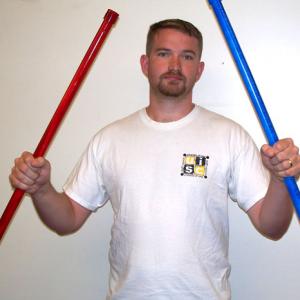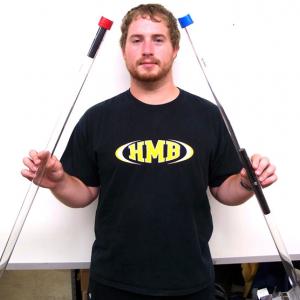College of Liberal Arts & Sciences
1Q10.10 - Inertial Wands
Give one wand to each of two students. Have them hold the wand at the center and rotate it back and forth. The student whose wand has the mass in the center will be able to rotate their wand much faster than the student whose wand has the mass located at the ends of the wand. The clear wands can be used to show the mass locations in the two opaque wands.
- Thomas K. McCarthy, "Moving Up the Ladder", TPT, Vol. 34, # 8, Nov 1996, p. 503.
- Ian Thomas, "Another Rolling Paradox", TPT, Vol. 32, # 4, April 1994, p. 200.
- David R. Lapp, "Moment of Inertia with PVC Pipe and Iron Rebar", TPT, Vol. 32, # 2, Feb. 1994, p. 115.
- R. D. Edge, "Crystal Sticks", TPT, Vol. 29, # 2, Feb 1991, p. 128.
- R. D. Edge, "Rotational Inertia", TPT, Vol. 26, # 6, Sep. 1988, p. 405.
- R. D. Edge, "Moments of Inertia", TPT, Vol. 17, # 9, Dec 1979, p. 599.
- Walter Q. Quint, "A Demonstration of Moment of Inertia", TPT, Vol. 15, # 9, Dec 1977, p. 546.
- William R. Mallory, "Moment-of-inertia demonstrator", AJP, Vol. 43, #6, June 1975, p. 563.
- Robert Ehrlich, "F.19, Moment of Inertia of a Hula Hoop", Turning the World Inside Out, p. 87.
- Martin C. Sagendorf, "Rotational Inertia", Physics Demonstration Apparatus, 2009. p. 101.
- Borishlaw Bilash II, David Maiullo, "Inertial Wands", A Demo a Day: A Year of Physics Demonstrations, p. 162.
- David R. Lapp, "Moment of Inertia with PVC Pipe and Iron Rebar", Apparatus for Teaching Physics, p. 48, Edited by Karl Mamola.
Disclaimer: These demonstrations are provided only for illustrative use by persons affiliated with The University of Iowa and only under the direction of a trained instructor or physicist. The University of Iowa is not responsible for demonstrations performed by those using their own equipment or who choose to use this reference material for their own purpose. The demonstrations included here are within the public domain and can be found in materials contained in libraries, bookstores, and through electronic sources. Performing all or any portion of any of these demonstrations, with or without revisions not depicted here entails inherent risks. These risks include, without limitation, bodily injury (and possibly death), including risks to health that may be temporary or permanent and that may exacerbate a pre-existing medical condition; and property loss or damage. Anyone performing any part of these demonstrations, even with revisions, knowingly and voluntarily assumes all risks associated with them.

